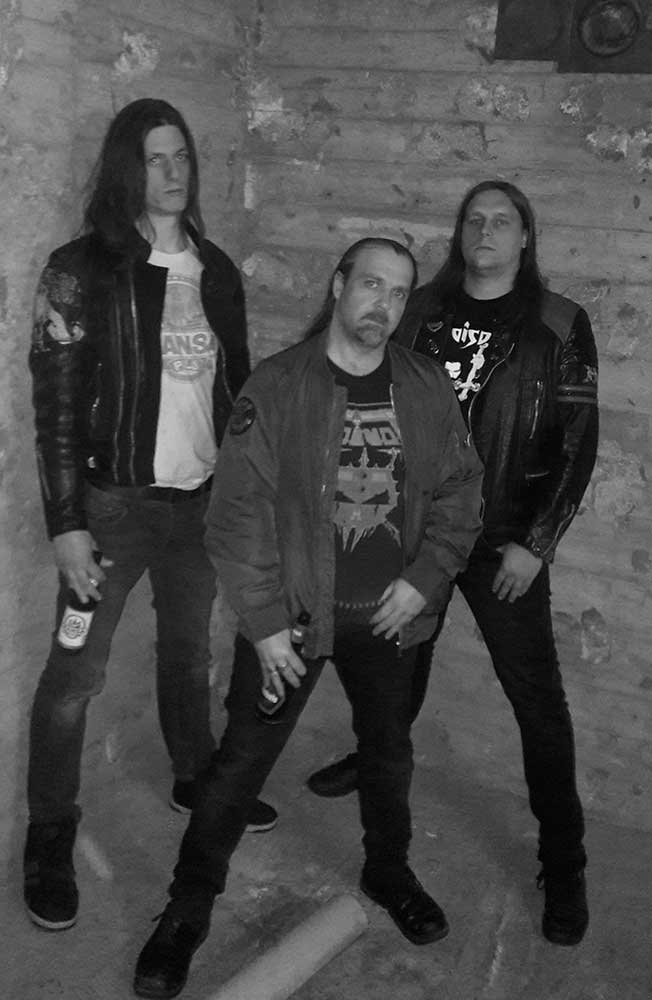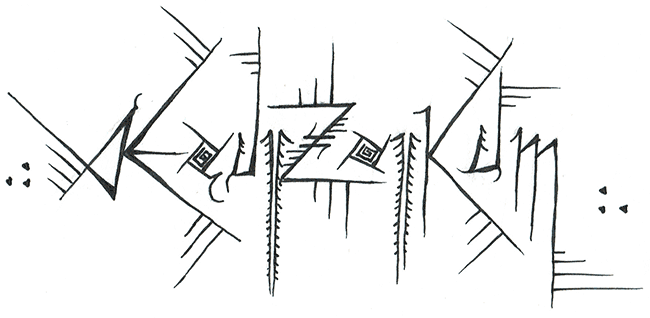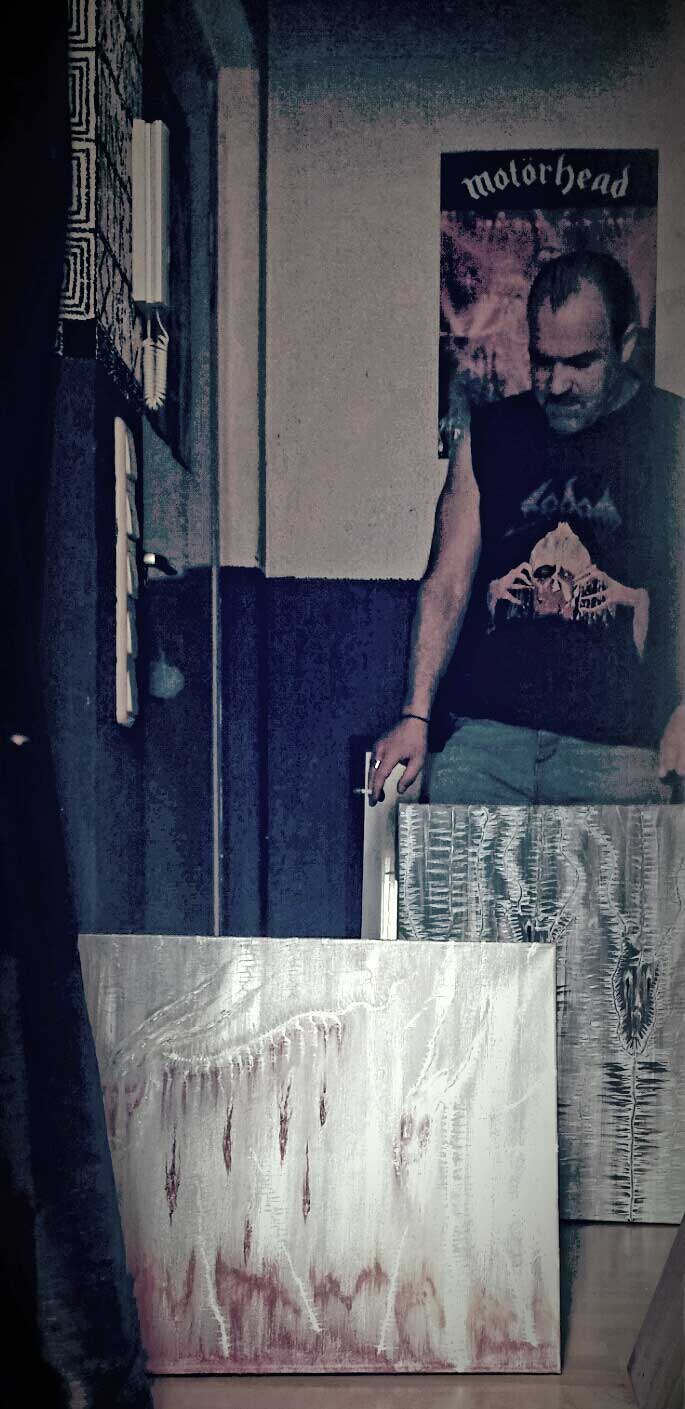Khthoniik Cerviiks
2020-06-24
by Niklas Göransson
German underground metal peculiarity Khthoniik Cerviiks return with delusions of death and dystopian uniformity – Okkhulus Siirs and Khraâl Vri*ïl speak about the nuts and bolts operating their musical machinery.
– It’s not easy to describe what it is we do, says Okkhulus Siirs, because we have no intentions of adhering to any specific genre. When Gharmonboziia (drums) says he feels like playing a punk beat, we incorporate it. When Khraâl Vri*ïl (guitars) wants a simple but super-catchy New Wave or Neil Young-style lead melody, we implement one. But, in the end, we always manage to mould everything into some kind of death or black metal. Our basic song structures build on riff ideas that emerged during rehearsals – then, at some point, with two or three instrumentals sewn up, we need to start considering titles and lyrical content. For the new album, Khraâl Vri*ïl came up with the idea of basing a few lyrics on research he’s done about Cotard’s syndrome – a mental illness that, briefly summed up, makes its sufferers believe they are actually dead.
This very unusual neuropsychiatric disorder is also known as Cotard’s delusion or, my personal favourite, walking corpse syndrome. To exemplify how it manifests – in 2008, a fifty-three-year-old woman was brought to a New York psychiatric ward after repeatedly announcing to her family members that she had died, begun decomposing, and wished to be taken to the morgue. One day in 2012, a sixty-nine-year-old Japanese gentleman sought out his doctor and said, ‘I guess I am dead. I’d like to ask for your opinion.’ Despite admitting that those who have perished usually cannot speak, he remained convinced about his bereavement. In 2009, an eighty-eight-year old man in Belgium who received medical attention for depression confided in his psychiatrist that he had died recently. Even worse, he was devastated and most concerned that no one had yet seen fit to bury him. In an exceptionally rare combination of unusual exotic ailments, an Iranian fellow, thirty-two years of age, was diagnosed with both Cotard’s syndrome and clinical lycanthropy after being adamant that he had not only died but also been transformed into a dog.
– This has similarities to the theme of our first album, “SeroLogiikal Scars” (2015), which was roughly spun around my experience with the concept of so-called serological scars. We wanted also our second full-length record to follow certain guiding principles. Like the debut, “Æquiizoiikum” is not meant to be a concept album in the traditional sense; it’s a collection of stories and perspectives based on a visual framework. The idea of the ‘Æquiizoiikum’ was birthed by Khraâl Vri*ïl; imagine a futuristic dystopian era where total uniformity is being installed on every level, both subtly and forcefully. Don’t get me wrong – it’s not about equality in the socio-political sense, but about merciless, technocratic, anti-human, braindead sameness allowing only for black-and-white-thinking.

“Æquiizoiikum”, which is due for release on July 17, 2020, courtesy of Iron Bonehead Productions, was recorded in the same manner as all the remaining KHTHONIIK CERVIIKS releases.
– Our studio approach is actually pretty much like an advanced demo recording, so to speak. We play the basic instrumental tracks, live and in a room together, just like we would at rehearsal. It’s simply the way to go for us, because we never really practise performing our parts separately. Setting everything up, sound-check, microphone placement, and the actual recording – including several takes per song – is usually done in two and a half days, max. That leaves one day for additional guitar tracks and another for vocal recordings. This way, we can record an entire album in only four days while still getting an end result with the live fundamentals at its core, determining the pace and feel of the entire thing. All three of us are dependent on each other during these core sessions, no one sits around waiting.
One drawback when it comes to this methodology is that recording all together in the same room – with individual sounds bleeding into multiple microphones – makes it almost impossible to edit and fix even minor mistakes afterwards.
– Yes, many musicians and producers consider these points to be huge downsides. However, to us, it’s the best possible representation of what it is we do, week after week, without getting lost in pointless perfectionism. We’re just a group of guys playing music together, and I’d be totally unable to stand behind a KHTHONIIK CERVIIKS album with every single instrument edited straight to the grid in a robot-like fashion; that’s just not how we play. Another benefit of recording a good portion of an album live is how it allows you to use the room’s natural reverberation, as captured by the additional mics. You may want to compress these room tracks and mix them slightly underneath the close mics for a nice organic reverb that serves as glue and thicker bottom. Of course, all this would be possible with software or hardware reverbs too – and there is indeed such additional effects on the snare and vocals, for instance – but the heart and soul of any KHTHONIIK CERVIIKS recording is the full band in a room together at one and the same point in time.
Recording live in this manner, with complex song arrangements to boot, must surely demand a ridiculous amount of rehearsing. However, I read that Khraâl Vri*ïl works from dawn to dusk, Monday to Saturday, so KHTHONIIK CERVIIKS can generally only practise once per week.
– He still does, then add to that almost two hours of commuting every workday. On Saturdays though, he clocks-off earlier in the afternoon. So yes, practising only once per week requires some organisation, but it’s become a tradition of sorts by now. For roughly two months before a live show, we rehearse nothing but the current setlist. When there’s more time between gigs, we start collecting and arranging ideas for the next record. It takes us a year or two to write a full album this way and, therefore, we’re usually well-prepared for our studio appointment when that day comes.
Do you ever wonder how KHTHONIIK CERVIIKS might sound if you were able to dedicate more time to it?
– I actually don’t think we’d be more productive or efficient if we were to lock ourselves in the rehearsal room for several days. Maybe it could be beneficial to final preparations for shows or recordings, but not necessarily to our creative process. In such a scenario, sooner or later everyone would be concerned with getting some food or sleep, making phone calls, or whatever individual needs and moods may arise. Locking oneself in with the aim of being as creative as possible may, sooner or later, very well turn writing into a race against time. However, with only one fixed appointment per week, we get a session of total dedication to KHTHONIIK CERVIIKS; nothing else counts during these two hours. It is our most treasured weekly escape from everyday life.

Khraâl Vri*ïl‘s guitar playing is obviously one of the foundations of KHTHONIIK CERVIIKS. From what I’ve gathered, there are quite a few subtleties going on – which is what gives the melodies that hazy extra punch.
– In 1988, says Khraâl Vri*ïl, when I first started playing guitar, I was only hitting strings and placing fingers on the fretboard… searching for appropriate tones, perhaps learning through dissonance, heh. Shortly thereafter, I was given an instructional book with all the classic metal techniques – power chords, muted strings, and lead scales that shake your bones. To be honest, none of this ever really appealed to me. It felt like turning music into some kind of competition, or sport; a total lack of feeling, you know. Furthermore, there has been a constant non-metal influence from guitar players I really loved as a novice and who remain omnipresent in my fingers to this day.
I’m assuming VOIVOD had some role?
– Of course, I really appreciate Piggy‘s style, but it wasn‘t the main essence of VOIVOD. Their genius emerged from a collective resonance and growth within themselves, something a band has to FEEL. The rest is superfluous. Accordingly, no fretboard heroes were to blame for my sleepless nights; instead, I was trying to figure out from where the haunting delays, drones, and self-taught caresses of strings executed by still-admired titans of mine such as Neil Young and East Bay Ray came. Just listen to HÜSKER DÜ – this is amazing stuff, pure ‘molten metal sounds’ as Bob Mould’s playing was described back in the day. So, I just tried to combine essentially all the stuff that moved me in the past. Maybe it’s just a copycat approach based on stepping on pedals whenever it feels right.
When KHTHONIIK CERVIIKS performs live, Khraâl Vri*ïl can be spotted frequently pushing his pedals under certain riffs.
– His switching between pedals is one important aspect to these subtleties you mentioned, says Okkhulus Siirs. Imagine a riff with an eight-count, where the delay effect is used only on three and five. Sounds much cooler than a delay on all eight counts. However, it also means he must step on the pedal four times during an eight count. So, he’s often playing guitar with two hands and one foot.
Is there anything similar going on with the bass?
– The bass is performed more traditionally; I just use a chorus pedal on some parts. On the other hand, for years I was completely obsessed with finding a good bass sound by using only cheap pedals. I went through about twenty different distortions, overdrives, and preamps – purchasing and re-selling them one after the other, until I found what I actually consider a basic tone, haha.
What did you end up with?
– I first run my bass into a blender pedal to split the signal. One output goes into a limiter – meant to even out the dynamics of the clean signal – whereas the other goes into a Tube Screamer clone that I’ve modified for better bass response. Both the clean and overdriven signals run back into the splitter pedal, which then allows me to blend both channels according to taste. I tried dozens of bass pedals with internal blend functions; however, these always sounded to me like two signals stacked on top of each other. Splitting the signal externally and compressing, or limiting, the clean portion individually helped me blend it perfectly back in with the overdriven portion. This blended signal then runs into a cheap clone of a well-known bass preamp with DI recording output that I’ve modified with two additional switches for better mid-range representation. My amp has an optical compressor and a tube preamp which I deem important to generate the warmth and ‘clank’ that I like, but also to retain a certain smoothness within the tone. I replaced the cheap Chinese tubes it contained with better ones and, although it’s low voltage in design, the change was really noticeable. So, my approach is rather focused on avoiding overpriced fancy equipment in favour of cheap clones I can modify with a bit of wire, some switches, and a soldering iron.
Returning to guitar for a moment, I read an impassioned case from Okkhulus Siirs about how German guitarist Michael Schenker’s 1973 initiation into UK rock band UFO served as the true spark which birthed New Wave of British Heavy Metal. He called for a revision metal history, and for NWOBHM to be dated six years earlier. Essentially, I think what he’s saying is that he hates BLACK SABBATH.
– I like BLACK SABBATH a lot throughout most of their output, including the records with Dio and Tony Martin. I can agree that they invented heavy metal, but I feel the narrative of metal history is incomplete when people mark SABBATH as the starting point and then mention the NWOBHM flood of records between 1979 and ’81 as the second step. A lot of influential stuff happened even before 70s MOTÖRHEAD and JUDAS PRIEST. I think UFO’s “Phenomenon” album – especially due to Schenker’s guitar work – played a huge role in the development of NWOBHM. But so did BUDGIE, THIN LIZZY and many more. I know I’m not making a new point at all by mentioning some 70s bands in this context, but it’s just that I think early UFO is somewhat underrated.

KHTHONIIK CERVIIKS was the result of the last three men standing when two different bands in the same rehearsal complex broke up. To my understanding, the early material came together as a sort of fusion between the two bands.
– There was never any agreement among us to do specific things, says Okkhulus Siirs, we just threw our ideas together, old and new, and elaborated on them together. Then, we just sat back and watched the brew beginning to ferment. And we soon found ourselves hooked on that stuff. At first, I considered using some lyrics which were originally written for my former band but – after a couple of rehearsals, when the direction of KHTHONIIK CERVIIKS started taking a more graspable shape – I decided to write new lyrics based on time-space-relationships and post-apocalyptic thoughts. Khraâl Vri*ïl was thinking along the same lines when it came to lyrical content. Some of the riffs, bass lines, and drum structures we’ve been using so far would probably have gone onto other bands’ records if we hadn’t founded KHTHONIIK CERVIIKS. Sometimes, you just have some stock ideas and try to apply them when you feel the time has come. But these stock ideas only make up a small portion of the compositions. At times, they served as starting points for our jamming, or trial and error sessions, or whatever you want to call it… during which we tried to shape these individual ideas into a joint experience.
I’m wondering when – as in, how far into the composition process – they came up with the name KHTHONIIK CERVIIKS. Because it really reflects how the music sounds, I think. Not in a literal meaning, but rather in sound and aesthetic.
– I’m not a hundred percent sure as to exactly when Khraâl Vri*ïl suggested the band name, but I think it must’ve been after six or seven rehearsal sessions when we had two songs that were more or less finished. I think the name reflects the entire concept perfectly. I’d even say that it strongly influenced the band’s concept from that point on. It refers to a mythological and mystic sphere as well as to a physical, biological, or scientific level. Sometimes, these two dimensions amalgamate seamlessly and sometimes they fight each other throughout our lyrics. Since we like to be creative with language and use it as a flexible material, we were keen on choosing a somewhat distorted and phonologically ‘damaged’ band name too.



